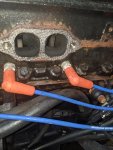hi, just took off risers and manifolds from mercruiser 6.2 mpi 2002 built
both manifolds seems to be in good condition, no corrosion inside, risers also seem to be OK
when looked into engine ports on port side i noticed some corrosion spots.
i will be replacing both sides manifolds/risers, however - what do i need to do about those corrosion spots? do i clean them or let them burn trough ?
thanks !
both manifolds seems to be in good condition, no corrosion inside, risers also seem to be OK
when looked into engine ports on port side i noticed some corrosion spots.
i will be replacing both sides manifolds/risers, however - what do i need to do about those corrosion spots? do i clean them or let them burn trough ?
thanks !





















